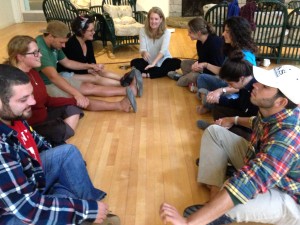Oct 12, 2013 Communication Skills Building Activities Part One
One of the most fundamental aspects of team-building and developing a positive learning and working environment is effective communication. Communication skills are an incredibly important social-emotional skill necessary for success in the 21st century workplace. Group facilitators and educators often look for activities to practice communication skills and explore how communication works in a group and how to improve it – whether it is between staff members, levels of an organization, or student to student. Over the next few posts I will offer some of my favorite activities to initiate reflection and conversations around communication.
 “Telegraph” is one of my favorite communication focused activities. Not only does this activity jumpstart reflection about communication, it also builds trust, initiates reflection on the pitfalls of gossip and the importance of thinking before acting. It also can be integrated into a lesson on probability in math classes.
“Telegraph” is one of my favorite communication focused activities. Not only does this activity jumpstart reflection about communication, it also builds trust, initiates reflection on the pitfalls of gossip and the importance of thinking before acting. It also can be integrated into a lesson on probability in math classes.
Telegraph
Purpose: To practice and explore probability, Communication and Miscommunication, Trust, Collaboration, Thinking Before Acting, Executive Functioning
This “tried and true” activity has been one of my favorite ways to engage groups in a discussion around communication, thinking before acting or making a comment, and reflecting upon how their actions affect others, gossip and rumors. Participants love the playful and competitive nature of this game that helps students practice handling competition, fairplay, and healthy trust. The game requires appropriate touch, which can become another social skills lesson in itself for many groups. It is a great method for exploring probability in math.
I have been purposely timing this with my 7th grade students to fall during their probability unit. We use it to practice the social-emotional and community skills mentioned above and reinforce what they are learning about probability.
Directions:
- In the probability lesson variation give a short lesson on probability and predictions
- Create two equal teams and have participants sit in chairs or on the floor in two rows facing each other.
- A novel object such as a rubber chicken is located precisely between the last people in each row.
- Ask team members to hold hands (a lesson in itself for some groups).
- Everyone closes his or her eyes except the first person in each row.
- The front participants are instructed that they need to watch the facilitator flip the coin.
- If they flip heads, participants send the squeeze down the line. If it is tails they don’t! If group members feel a squeeze they pass it down the line.
- The first team to grab the chicken wins. BUT- if they squeeze on tails they lose a point.
- When it reaches the last person, they grab the object. Whoever grabs the object first wins that round.
- Have students predict how many tosses will be heads and how many tails.
- Rotate front to back after each turn. Team switching can be helpful to eliminate some negativity with competition; every so often I have “anyone with a summer birthday” or “anyone wearing green” switch to the other team. This adds a little fun and controlled chaos, potentially evening out the teams and helping the group let go of the score keeping.
- With uneven groups – use an extra person to rotate in and out of the “judge” position down at the end of the game or to be the coin flipper.
- I often stop the game a few times to discuss the social-emotional skills lessons that inevitably arise with the “miscommunications” that occur. This game is a great metaphor for what happens in school around passing along incorrect information, acting before thinking, gossip etc.
- When the game ends we tally and discuss probability.
Outcomes: Along with exploring and reinforcing probability and predictions, this activity naturally lends itself to meaningful conversations around communication and miscommunication, gossiping, passing on messages without getting the right information etc.
Reference: This is an adapted version of the game found in Tom Jackson’s Activities That Teach Book.



Cheryl Lower Coonahan
Posted at 07:40h, 10 OctoberDear Jen,
I’m so glad to have found out about you and your website. I’m an organization consultant who also does management training and it HAS to be experiential to succeed. I’m always looking for new ideas and will use this activity this week, citing your business, of course. I can’t wait to poke around and see what other gems you have.
Thanks and regards, Cheryl Lower Coonahan, Fulcra Consultancy (just 80 miles from Vermont)